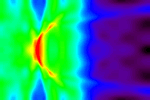ESTO CT Investigators Receive Time on NASA's Columbia Supercomputer
ESTO CT Investigators Receive Time on NASA’s Columbia Supercomputer
![]()
NASA’s
Science Mission Directorate recently awarded members of ESTO Computational
Technologies (CT) Project investigation teams a total of 3.65 million
processor-hours on NASA’s Columbia supercomputer. Columbia is a 10,240-processor
SGI Altix system located at Ames Research Center in Moffett Field, CA.
Capable of performing over 50 trillion calculations per second, Columbia
is currently the second fastest supercomputer in the world. CT-affiliated
awardees received time allocations ranging from 100,000 to 1.5 million
processor hours over the next year.
 |
|
|
From one of the first gamma ray burst simulations |
The Columbia awards are as follows:
Venkatramani Balaji, Princeton University, 1) Coupled Ocean and Atmosphere
Data Assimilation System for Climate of the 20th Century, 2) Modeling
of Entire Hurricane Season Using High-Resolution Non-Hydrostatic models
Alan Calder, University of Chicago, The Application of an
Interoperability Based Environment for Adaptive Meshes to Radiation-Hydrodynamic
Models of Gamma-Ray Bursts (IBEAM)
Andrea Donnellan, Jet Propulsion Laboratory, Simulating
Earthquake Processes on High-End Computers
Tamas Gombosi, University of Michigan, Halloween Storm Simulations
with the Space Weather Modeling Framework
Christa Peters-Lidard, Goddard Space Flight Center, High-Performance
Simulation and Data Assimilation with High-Resolution Land and Atmosphere
Models and Advanced Computational Technologies
Michele Rienecker, Goddard Space Flight Center, 1) Advanced
Data Assimilation into a High-Resolution Global Ocean Model Using an Ensemble
Kalman Filter, 2) High-Resolution Coupled Climate Simulations
Max Suarez, Goddard Space Flight Center, Development of
GEOS-5 Atmospheric Assimilation System